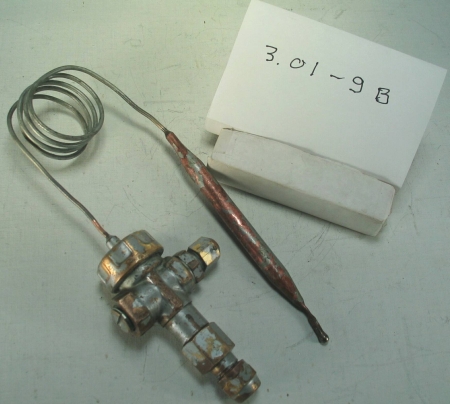Refrigerant Flow Controls – Household
An amazingly compact, light weight [8oz.], new generation of brass body, adjustable thermostatic expansion valves, for household and small commercial equipment applications, with 30″ capillary tube and bulb, designed for a methyl chloride, Patented 1934, Model LM, Mayson Mfg. Co. Detroit. Circa 1938. [one of a matched set of two, see ID # 177, similar to ID #177 without Kelvinator markings]
Beautifully proportioned brass body with engraved markings
Technical Significance:
The advances in the engineering, production and application of thermostatic expansion [TX] valve technology throughout the industry in the 1930’s were truly impressive, as the valve moved into the mainstream of refrigerant flow control applications, replacing much cruder metering devices, including float valves and automatic pressure setting valves. TX valve technology enabled much more efficient use of evaporator [cooling unit] surface and thus the use of smaller evaporators
Now designed for a new generation of fluorinated hydrocarbon refrigerants, these valves were engineering masterpieces of their times, compact, precisely calibrated, and reliable refrigerant flow control devices. Valves were ordered refrigerant specific.
An exquisitely engineered and crafted brass body valve, it is driven by a miniature brass bellows, with extended copper capillary line and 3/8″ sensing bulb – an impressive example of precision, mass production and quality control methods of the period.
Compact and reliable, with capacities up to 1/3 ton, Mayson’s Model L series TX valves would become a kind of “work horse” for the repair and replacement field, to be shown in wholesalers’ and jobbers’ catalogues through into the 1960’s. see bibliographic note
It was often used to up-date earlier equipment using an automatic expansion valve, in order to improve evaporator efficiency, and sometimes accompanying a conversion from methyl chloride to R12 refrigerant.
Industrial Significance:
This valve carries the surprisingly early patent date of 1934, marking Mayson as one of a small number of pioneers in the early development of TX valve technology for a new generation of refrigerants and refrigeration applications.
The contrast between the sophistication of this valve and the offerings of Frigidaire, a brand label, is most marked, much smaller and more polished in appearance, see for example ID #179, and others that follow.


